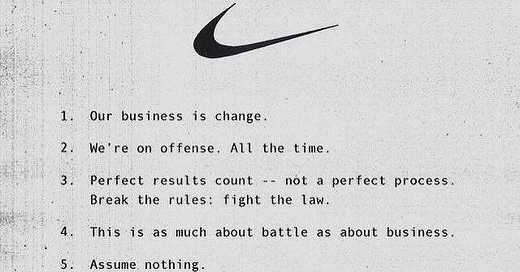Venturing Insights #14 - It's all about Culture
It's about creating an environment where ideas can flourish and that technology can be leveraged effectively.
The summer breeze is bringing me fresh inspiration, so I’m thrilled to introduce a new short series: “It’s all about.”
This decision came to me as I reflected on my previous newsletter, which coincidentally touched on a fundamental aspect of innovation under the title "It's all about Knowledge." That post, focusing on the crucial role of knowledge flows, unknowingly set the stage for what I now envision as an exploration of the core elements driving success in open innovation and corporate venturing.
So, consider this our official series kick-off! Each post will dive deep into a critical component of (corporate) innovation. By examining these elements one by one, we aim to provide you with focused, actionable insights to elevate your innovation strategies.
Today, we're turning our attention to another vital aspect: organizational culture.
Culture: The Invisible Force Behind Innovation
Company culture is the shared values, beliefs, attitudes, and practices that characterize an organization and guide employee behavior. It's essentially the personality and atmosphere of a company, shaping how work gets done and how people interact.
While knowledge may be the fuel, culture is the engine that drives innovation.
Of course, it's not just about spreading great buzzwords in every corporate communication. It's about creating an environment where ideas can flourish and that technology can be leveraged effectively.
The Cultural Challenge in Open Innovation
Many companies eagerly embrace open innovation, expecting a flood of groundbreaking ideas and an effective adoption. Yet, as Harvard Business Review points out, the results often fall short of expectations. Why? The answer lies in culture.
It's not the lack of ideas or technology that's the problem. It's the subtle, often unspoken rules of "how we do things around here" that can make or break innovation efforts. Internal politics, the infamous "not invented here" syndrome, and resistance to external ideas often stifle potential breakthroughs before they can take root.
Lessons from the Design World and HBR
To overcome these cultural barriers, let's look at a peculiar source of wisdom: independent design agencies. These entities, whose survival depends ultimately on their clients’ using their ideas, have long faced this same challenge.
They have developed a variety of techniques to encourage clients to adopt their concepts. Their secret? A blend of trust-building and adaptability that we can all learn from:
Create a multi-layered network: Build relationships across various levels and departments, creating a rich tapestry of perspectives that can withstand the loss of any single connection.
Foster equal ownership: Emphasize shared ownership of ideas and projects, turning skeptics into enthusiastic participants.
Establish interim milestones: Break your innovation journey into bite-sized chunks, setting clear milestones to build consensus and adjust course as needed.
Build an open business case: Present flexible ideas that invite stakeholder input, fostering a sense of ownership that can turn potential critics into champions.
Prototype early: Use early prototypes or minimum viable products to transform abstract concepts into tangible realities, building trust and demonstrating progress.
Some Practical Tools for You
Understanding the importance of culture is crucial, but how do we actually assess it? Here are some practical tools to help you gauge your innovation culture:
Competing Values Framework (CVF): Evaluates culture across flexibility vs. stability and internal vs. external focus dimensions.
Denison Organizational Culture Model: Assesses adaptability, mission, involvement, and consistency.
Innovation Quotient (IQ): Measures innovation capability across various dimensions.
KEYS to Creativity and Innovation: Focuses on work environment factors influencing creativity.
Cultural Web: Examines six interrelated elements of organizational culture.
Organizational Culture Assessment Instrument (OCAI): Helps identify current and preferred culture types.
Innovation Value Chain: Identifies weak links in innovation processes.
Remember, no single tool can capture the full complexity of your organization's culture. The most effective approach often involves using a combination of these tools to get a multi-dimensional view of your innovation ecosystem.
The Global Perspective: Navigating Cultural Diversity
As we zoom out to a global scale, the picture becomes even more fascinating. Research shows that innovation thrives in environments with lower power distance, higher individualism, and greater cultural diversity.
However, harnessing this diversity requires a special set of skills, often referred to as cultural intelligence (CQ).
For instance, decision-making in Japan often emerges from informal consensus-building discussions, while in the United States, decisions might be presented more directly. Understanding these nuances is crucial for creating an environment where diverse perspectives can truly shine.
Fostering a culture of innovation is ultimately about creating an ecosystem where trust, flexibility, and collaboration are the norm. By embracing cultural intelligence and actively involving a diverse range of stakeholders, companies can create fertile ground where breakthrough ideas don't just survive—they thrive.
In Conclusion
As we've seen, culture is the invisible force that can make or break your innovation efforts.
By understanding, nurturing, and regularly assessing your organization's culture, you can create an environment where innovation doesn't just happen by chance—it becomes a natural part of how you do business.
Remember, in the world of open innovation and corporate venturing, it truly is all about culture. But is it enough? Of course not. Even with the right cultural ingredients, organizations often face internal resistance. Traditional hierarchies and departmental silos can stifle the open flow of ideas. To overcome this, companies need to nurture collaboration across departments and establish dedicated teams focused on integrating external innovation. We’ll discover more in the next episodes.
Until next time, keep innovating and stay inspired!
A soundtrack for your day:









